
Week #6 Organized Home Challenge
Trash And Home Recycling Center
This week's challenge is to create a home recycling center that is attractive and functional, so it's easier for your family to go green, and recycle more of the waste created.
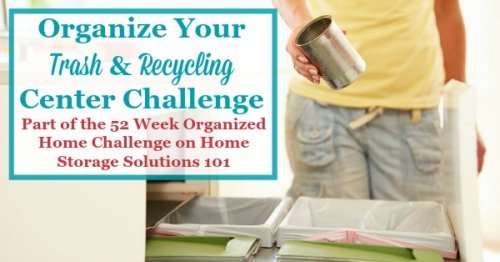
In addition, as much as we can recycle there is still plain old trash that we've got to deal with in our homes too.
Therefore, in addition we'll also focus on making the trash collection process smooth and efficient throughout the home.
As you know, we've been focusing on kitchen organization for the past few weeks, and although this week's challenge focuses on many areas in the home, most likely your family creates the most trash and recycling in the kitchen, so that's why I scheduled this challenge now.
Are you new here? The Trash and Home Recycling Center Challenge is part of the 52 Weeks To An Organized Home Challenge. (Click the link to learn how to join us for free for future and past challenges if you aren't already a regular reader).
I believe that the majority of the population thinks, at least in their head, that recycling is a good idea. However, to actually stop throwing stuff away in the trash, and instead to take the extra steps necessary to recycle, can often be difficult.
Fortunately, a little up front thought and planning, and some simple steps listed below, along with some organization and habits, turn something that seems like a lot of work -- recycling, into a habit that takes little time each day but can reap big rewards for the planet.
Step 1: Learn Your Local Regulations And Rules For What Can Be Recycled, And How
The first step of the Trash and Home Recycling Center Challenge is to find out what types of items you can recycle in your area, and how you must present those items to be recycled.
The challenge I had when creating this Challenge for you was that each municipality and region is different in the rules it has for recycling. In some areas recycling, at least of certain items, is mandatory, while for others it is voluntary.
Further, regions vary on whether they pick up recycling for you at the curb, or whether you must take it yourself from your home recycling center to a redemption center.
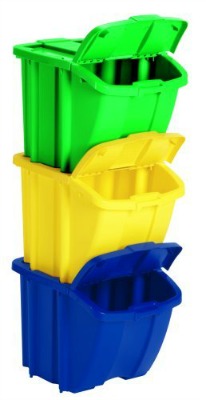 It can be easier to separate recycling as
It can be easier to separate recycling ascollected [Purchase on Amazon.com]
In addition, there is variation in what items are accepted for recycling, and also how you must separate the items to comply with rules and regulations.
The only way you'll create the most optimal Home Recycling Center for your family is to know what those rules are, and to use them as a guide to help you with the rest of the steps below.
These rules can be important, for instance, in deciding what types of trash and recycling bins and containers to use, and where to store them in your home.
Most municipalities or recycling centers have these rules available in a simple one or two page form for you to reference as needed.
Make sure you get a copy and post them somewhere you can reference, close to the home recycling center you'll create.
Then, if you forget a rule or need a reminder you'll easily be able to glance and find out what you need to know, at least most of the time, and make it easier for yourself to keep up with your recycling efforts.
Step 2: Consider Where In Your Home You Should Collect And Store Recyclable Items
The second step in the Home Recycling Center challenge is to consider where you should hold and store your recyclable items in your home. There are many factors to consider, which are discussed below:
The Main Categories Of Recyclable Items
The main categories of recyclable items include:
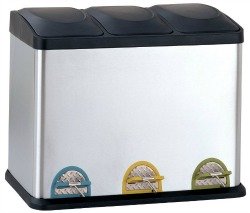 Stainless steel 3 compartment recycling bin
Stainless steel 3 compartment recycling bin[Click here to purchase on Amazon.com]
- Paper
- Plastic
- Glass
- Metals
Depending on your local rules, you may need to have separate containers for each of these types of items, or not.
Obviously, if you do need to separate them, multiple containers will take up more room, and therefore you'll need to be even more mindful of where you place them, or choose something attractive if it will be relatively large.
In such situations, having stacking containers (such as the ones above) can be invaluable, since they take up less floor space.
Long Term Versus Short Term Storage For Recycling
You'll also need to consider how much recycling will accumulate between the intervals when it is removed from your house, when determining which type of home recycling center containers to use.
For instance, if your region picks up recycling from the curb each week you may just need some small containers to hold everything, since it will be removed from your home quickly.
However, if you've got to take the stuff yourself from your home recycling center to the redemption center, especially if the center is very far away, you may accumulate much more recycling in your home before it is removed. In such cases you may need larger containers, and/or you may want to consider a short-term, and a long-term storage solution for holding your recycling.
Recyclable materials, especially those that held food items, tend to attract pests. Obviously, you should rinse such containers before placing them in your recycling bin, but you wouldn't keep trash in your kitchen for weeks at a time, so why would you do that for recyling?
Instead, you may need to have a place for longer-term storage of your recycling, such as in the garage, basement, or an outdoor storage shed, along with a more convenient short-term home recycling center in a more central place in your home (such as the kitchen, or area close to it).
Consider The Weight Of The Container, Recycable Contents And How You'll Transport It
If you've got to haul the recycling bin down a long driveway, or choose to have larger recycling bins or containers, you need to think about how you'll transport the bin, and its contents, where you need them to be.
Ideally, you want to use something with wheels. Unfortunately, not many recycling bins come with wheels, so you can use a child's wagon, a garden cart, or a trash can cart, such as the one shown to the left, to help save your back and move the recycling bins around.
You should also consider how heavy, or light weight, the container itself is, and choose one with handles if you want to pick it up and carry it.
If you choose stacking containers (such as the ones shown above) you may want to consider mounting them on a rolling dolly, so they can be wheeled out to the curb, or otherwise consider how you'll move their contents from your home recycling center to the distribution center as necessary.
Create A Main Home Recycling Center And Satellite Collection Areas
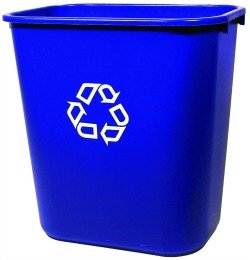 Make sure to have smaller collection bins
Make sure to have smaller collection binswhere need them [Purchase on Amazon.com]
The main room in your home that will generate items to go in your home recycling center is your kitchen, and therefore I suggest the main area in your home where you collect recycling be in or near your kitchen.
Therefore, look in or around your kitchen for space to create the main recycling center for your home. If the recycling containers are in plain view, try to choose something attractive. If they are hiden behind doors, or in a room close to the kitchen, such as a mud room or utility room, you don't have to worry about how they look quite as much.
Your kitchen is not the only room in your home that can generate recyclable items though. Typically, the following rooms are places where recyclable items can accumulate:
It's not a huge deal to take items from those locations to the main recycling area in your home, but let's face it, human nature suggests even the smallest obstacles can make you rather just dump something in the trash.
Therefore, I suggest adding small home recycle bins to key locations in your home to make it more likely that when you finish that bottle of shampoo or want to throw away that piece of paper, it heads to the recycling, not to the more conveniently located trash can. To learn more about this concept check out the daily mission that is part of this challenge where you're asked to do just this!
Label All Your Recycling Bins And Containers With What They Should Hold
Many times it isn't obvious that one container is for trash, versus another is for recycling. To alleviate this problem and any confusion it may cause for both family members and guests be sure to label all your recycling containers with the type of item it should contain.
This is especially helpful if you've got to separate your recyclables, or if you only recycle certain items, but not others.
Further, if you've got small children it may help to color code your labels, or put pictures on the labels to help them place their recycling in the right containers within your home recycling center.
Don't Forget A Kitchen Compost Bin
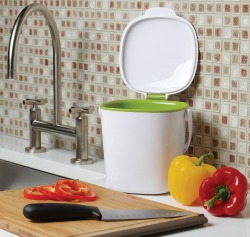 Oxo Good Grips Compost Bin
Oxo Good Grips Compost Bin[Click here to purchase on Amazon.com]
Don't forget that in addition to the main categories of recycling listed above, another big thing to "recycle" in your kitchen are your food scraps. If you've got a compost bin in your backyard, or there is a municipal bin where you can provide your scraps, why not do so?
All you need is a small kitchen compost container to either keep on your counter, or somewhere else convenient in your kitchen to hold the scraps until you add them to the main compost pile at regular intervals. Some people use an old coffee can, and others use a container designed specifically for containing their kitchen scraps.
There are various sizes and types of containers designed to hold your kitchen scraps, ranging for just a few days to a longer period of time. Remember, the longer you will hold the scraps in your kitchen the more you need to consider pests, such as fruit flies, and also odors.
Therefore, if you use such a container make sure to get one which suits your needs, keeping in mind how often you'll empty out your kitchen compost container.
Storage Solutions To Consider For Your Home Recycling Center
Above I mentioned some criteria to keep in mind when determining what recycling containers and bins to use in your home recycling center.
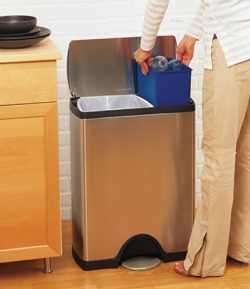 simplehuman Step Recycler
simplehuman Step Recycler[Click here to purchase on Amazon.com]
Although I've discussed lots of commercially available bins you can purchase, you can also be creative with the containers you choose, essentially recycling storage containers to use for the purpose of holding your recycling.
No matter what you use, keep these criteria in mind to choose the best types of containers for your situation to create your home recycling center:
- Wide, open facing bins with hinged lids can make it easy to add recycling (such as the stacking container shown above)
- Stacking containers (such as the same one mentioned above) can reduce the amount of floor space used
- Try to get light weight containers that are easily moved (or have wheels if possible) if you need to move the containers
- Confortable handles are also a plus if you'll be lifting them
Step 3: Place Trash Cans Or Baskets In Every Room
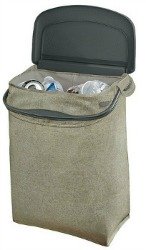 Rubbermaid Hidden Recycler
Rubbermaid Hidden RecyclerClick here for review
As much as we'd like to recycle everything, that really isn't possible, and even very organized homes make trash. In fact, some activity will occur in every room of your home that will create some form of trash.
Therefore, as part of this week's challenge I want us to also deal with all that trash in our homes, namely by making it easy for everyone in the family to throw their trash away, right away.
This may seem obvious, but if there is no trash can nearby you are more likely to leave your trash laying around. Soon, this becomes lots of clutter and makes the whole house feel unorganized. The simple solution - a trash can in every single room!
There are some considerations for the best trash cans for various types of rooms, so I'll break it down between the kitchen trash cans, and waste paper baskets for other rooms.
Kitchen Trash Cans
Your kitchen trash can should be large enough to hold one day's worth of kitchen trash. The reason is that you don't want to have to take it out more than once a day, but ideally you'll take out your kitchen trash at the end of each day to reduce odors and not attract pests.
There are two main types of trash cans I recommend for your kitchen. Which one you choose depends on your kitchen's layout, and your own preferences.
The first kind are under the counter pull out trash cans. These can be very handy, since the trash isn't visible from the outside, and it opens with just a pull on what looks like a big kitchen drawer. You can get one that accomodates two trash cans also, which can be very handy if you choose to use one as a trash can and one as a recycling container, for example.
In addition, stand alone trash cans are also very common, and work very well. If you're ever in the market to get a new one, choose one that is attractive, since it is visible. In addition, I recommend getting one that opens and closes easily, even when close to full and even when your hands are full, such as one which opens with a foot lever or a wave of the hand.
There are lots of nice kitchen trash cans. I've written an entire article on the pros and cons of various types of kitchen garbage cans, plus the one type you should never ever buy, if you would like more information.
Waste Paper Baskets And Trash Cans For Other Rooms
Trash cans in other rooms don't need to be as large as those for the kitchen, but still should be large enough to hold about a week's worth of garbage from that room.
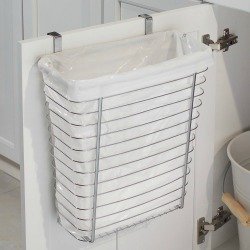 Over the cabinet door trash can holder
Over the cabinet door trash can holder[Click here to purchase on Amazon.com]
I have some really small trash baskets in my home, since certain rooms just don't generate much trash. However, get whatever size you need to keep the trash in that can from overflowing before you regularly empty your trash cans throughout your house.
Any place where you can generate messy trash, such as the bathroom or laundry room, get plastic or metal trash cans that you can clean easily. In other rooms, which only generate clean trash, such as paper for example, you can use any type of basket you wish, including wood, wicker, etc.
Sometimes it can be hard to find a place for a trash can in small spaces, like the bathroom, even though they are very much needed. Think outside the box a little and see if you can't find some place to put one.
For example, you could have a hanging trash can, which mounts to the inside of a cabinet door (see above to the right for an example), to get it out of the way.
I've made this task one of the Declutter 365 missions, so you can read the quick article about this task here.
Reminder: Don't forget about a trash can in your car too, which is discussed more in the Car Organization Challenge.
Step 4: Develop A Routine For Emptying Trash And Recycling
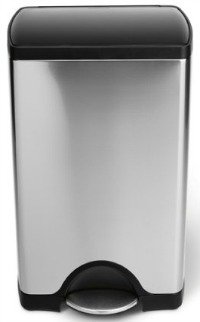 simplehuman Step Trash Can
simplehuman Step Trash Can[Click to purchase on Amazon.com]
The last step in the Trash and Home Recycling Center Challenge is to develop or keep your routine for emptying your trash and recycling, regularly.
Again, this seems really obvious, but you've got to keep removing the trash and recycling from your house on a regular basis to keep your home organized, and free of clutter.
Most of us already have a routine for taking out the trash from the kitchen, and also taking trash to the curb. Therefore, incorporating a similar routine for your home recycling center can piggy back on those tasks you already do and make incorporating recycling into your family's lifestyle simple.
I suggest dealing with your recycling in your home recycling center at least once a week. As part of that weekly routine I suggest doing the following:
- Gathering all the recyclables from the satellite collection areas and placing them in the main home recycling center
- Removing the contents from the main recycling center in your home and either taking things to the curb for pick up or moving them into your longer-term recycling storage in your basement, shed or garage
- Emptying all the small trash cans throughout the house into one bigger bag, and taking that to the outside trash can
- Taking outside trash cans to the curb for pick up
In addition, if you use the longer-term storage system for recyclables, you've also got to develop a routine to haul the recyclable items to the local recycling center from your home, typically on a monthly or quarterly basis.
You can check out more tips for how to develop a simple trash day routine here.

Listen To Taylor's Video Tips For This Week's Organized Home Challenge & Declutter 365 Missions
Do you want more in-depth tips and instructions for how to do this week's missions and challenge all about your trash and recycling areas? If so, I've got recorded video tips from me, Taylor, from the video archives in the Declutter 365 Premium group, all about this week's challenge and missions.
These video tips are available on demand in the archives, once you're a member of the group.
In Week #6's video I discussed the following topics, among others:
- Tidy up routine for flat surfaces, like kitchen counters and kitchen tables
- How do you know when you're making progress when decluttering?
- Develop a trash day routine
- Organization tips about recycling and trash collection
- Declutter 365 missions for week
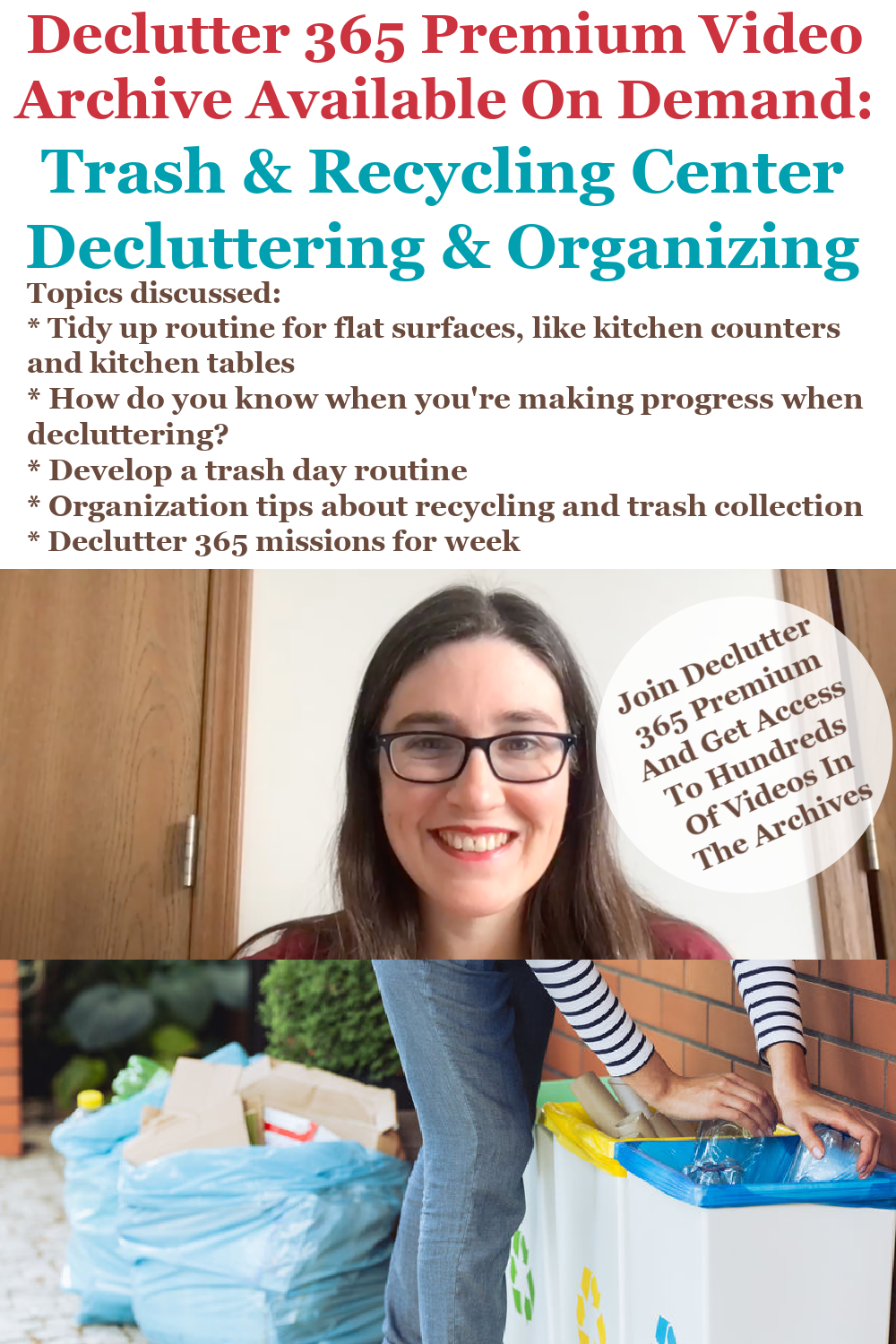
I suggest watching the video archive for the week, perhaps while you're doing some decluttering or cleaning around your home, before starting the week's missions and Challenge, and then you'll be able to breeze through this week's worth of decluttering missions, as well as organize what's necessary for the 52 Week Organized Home Challenge, based on the advice and instructions within those videos.
It really is like having me, Taylor, available, 24-7, as your decluttering and organizing coach, for every area of your home!
Plus, once you're a member of Declutter 365 Premium you get access to not only this video, but all the videos for the 52 weeks of the year, for 5 years (that's over 260 videos available in the archives!)

Get This Miscellaneous Decluttering Checklist + 32 Other Decluttering Checklists For Your Home
Right now you're decluttering your home, and there's a lot of items to declutter.
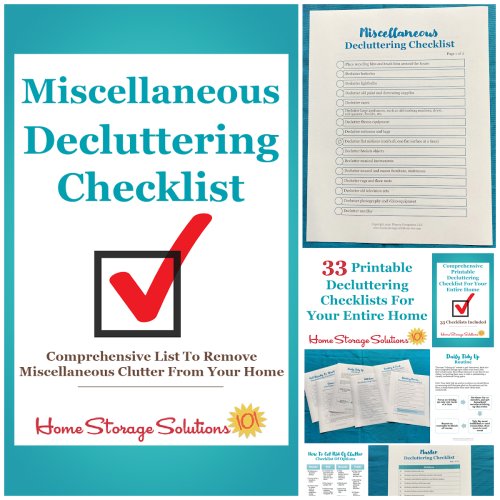
I've done the hard work of breaking down these tasks into smaller more manageable steps for you, so you don't get overwhelmed or worry you're forgetting a task, and you can go at the pace you want, whether that's fast or slow.
In addition, you can tackle these decluttering tasks in whatever order you want when you use these checklists!

Tell Me How The Trash And Home Recycling Center Challenge Is Going For You
I would love to know how this week's Trash and Home Recycling Center Challenge is going. You can tell me your progress or give me more ideas for how you've organized this area of your home below in the comments.
I also love before and after pictures of your home recycling areas, and explanations of what you've done to make it work for you and your family. Submit your pictures (up to four per submission) and get featured in the Creative Storage Solutions Hall of Fame. You've worked hard to get organized, so now here's your chance to show off!
Several people have already shared pictures of how they've designed and implemented their recycling areas in their home with me, which I've compiled into this hall of fame post. You should check it out for more ideas and inspiration.
Sneak Peek For Next Week's Challenge
We're working on our homes slowly, one area at a time, so don't get too distracted from the Trash and Home Recycling Center Challenge this week. However, I know people like to plan for what's next, so I'll give you a little sneak peek.
Although this week we've expanded from the kitchen just a bit to encompass any areas where we can gather recycling and trash, we'll be returning our attention starting next week back to the kitchen completely to finish out the last few weeks for this room.
Next week we'll focus on how to organize coupons, especially for purchasing groceries and other needed household items, and then finish off working in the kitchen the week after that with a discussion of meal planning and organized grocery shopping.
Make Sure You Make The Most Of These 52 Organizing Challenges
Get your copy of the printable one page 52 Week Organized Home Challenge schedule for the year here, so you can see all the challenges we're working on.

Further, if you'd like to join a community of others who are all commmitted to these organizing challenges and corresponding decluttering missions, and want more interaction with me, Taylor, video archives of Taylor providing more tips for each of these challenges and missions, as well as live monthly group coaching sessions focusing on the skills and habits necessary to maintain your home from now on, I'd urge you to join the private and exclusive Declutter 365 Premium Facebook group (you can learn more about it at the link).
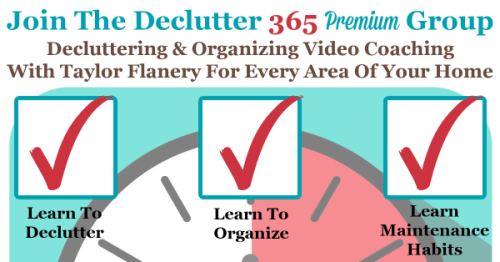
In addition, have you gotten your Declutter 365 Products yet, to make sure you can get even more assistance with decluttering and organizing your home this year? There are both free products (like the Declutter 365 calendar, a $20 value), as well as add-ons, such as daily text messages, planner stickers, and a Premium Facebook group, as well as a pack of printabe decluttering checklists.
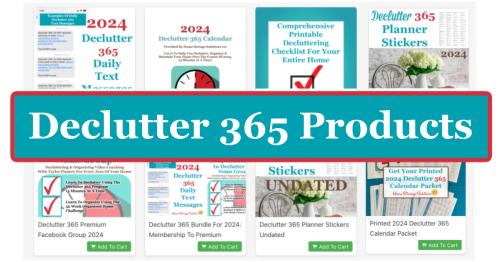
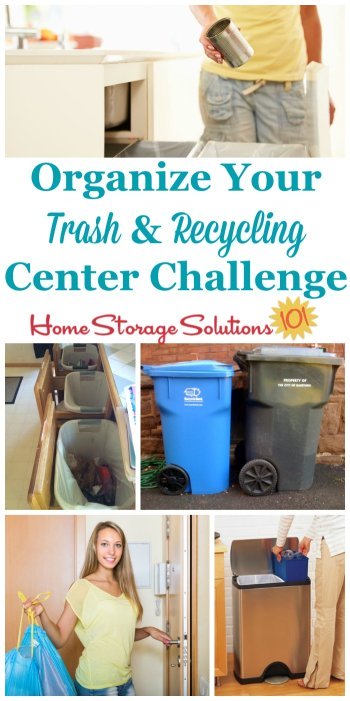
Some links on this page are affiliate links, meaning that if you purchase a product through them I receive a small commission which helps me provide this information to you for free, plus support my family. My integrity and your satisfaction are very important to me so I only recommend products I would purchase myself, and that I believe would benefit you. To learn more please see my disclosure statement.
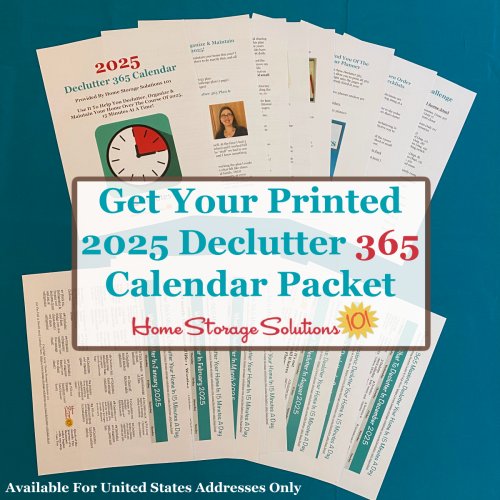
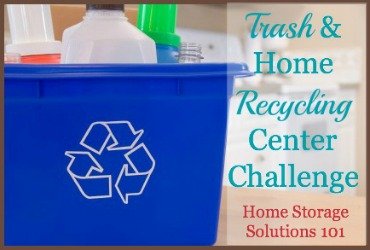

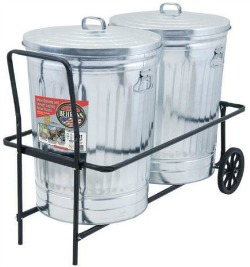
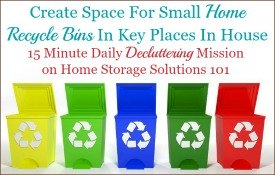
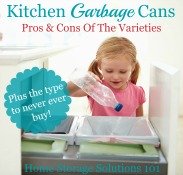
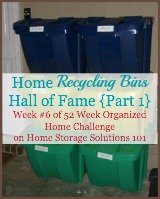
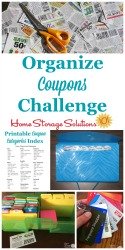
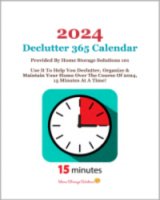
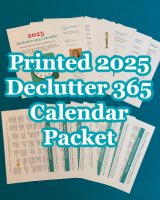
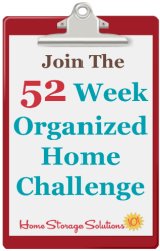



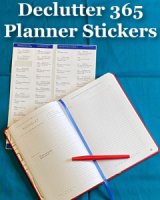

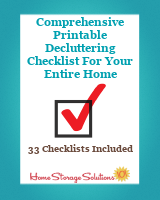


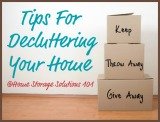
Share Your Comments, Tips & Ideas
I would love to hear from you, sharing your thoughts, questions, or ideas about this topic, so leave me a comment below. I try to always respond back!